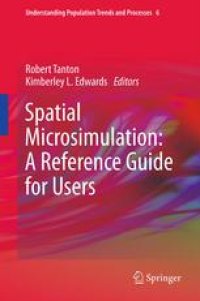
Ebook: Spatial Microsimulation: A Reference Guide for Users
- Tags: Demography, Statistics for Business/Economics/Mathematical Finance/Insurance, Geography (general), Quality of Life Research
- Series: Understanding Population Trends and Processes 6
- Year: 2013
- Publisher: Springer Netherlands
- Edition: 1
- Language: English
- pdf
This book is a practical guide on how to design, create and validate a spatial microsimulation model. These models are becoming more popular as academics and policy makers recognise the value of place in research and policy making. Recent spatial microsimulation models have been used to analyse health and social disadvantage for small areas; and to look at the effect of policy change for small areas. This provides a powerful analysis tool for researchers and policy makers.
This book covers preparing the data for spatial microsimulation; a number of methods for both static and dynamic spatial microsimulation models; validation of the models to ensure the outputs are reasonable; and the future of spatial microsimulation. The book will be an essential handbook for any researcher or policy maker looking to design and create a spatial microsimulation model.
This book will also be useful to those policy makers who are commissioning a spatial microsimulation model, or looking to commission work using a spatial microsimulation model, as it provides information on the different methods in a non-technical way.
Content:
Front Matter....Pages i-viii
Front Matter....Pages 1-1
Introduction to Spatial Microsimulation: History, Methods and Applications....Pages 3-8
Building a Static Spatial Microsimulation Model: Data Preparation....Pages 9-16
Front Matter....Pages 17-17
An Evaluation of Two Synthetic Small-Area Microdata Simulation Methodologies: Synthetic Reconstruction and Combinatorial Optimisation....Pages 19-47
Estimating Small-Area Income Deprivation: An Iterative Proportional Fitting Approach....Pages 49-67
SimObesity: Combinatorial Optimisation (Deterministic) Model....Pages 69-85
Spatial Microsimulation Using a Generalised Regression Model....Pages 87-103
Creating a Spatial Microsimulation Model of the Irish Local Economy....Pages 105-125
Linking Static Spatial Microsimulation Modelling to Meso-scale Models: The Relationship Between Access to GP Services and Long-Term Illness....Pages 127-143
Projections Using a Static Spatial Microsimulation Model....Pages 145-160
Limits of Static Spatial Microsimulation Models....Pages 161-168
Front Matter....Pages 169-169
Moses: A Dynamic Spatial Microsimulation Model for Demographic Planning....Pages 171-193
Design Principles for Micro Models....Pages 195-207
SimEducation: A Dynamic Spatial Microsimulation Model for Understanding Educational Inequalities....Pages 209-222
Challenges for Spatial Dynamic Microsimulation Modelling....Pages 223-245
Front Matter....Pages 247-247
Validation of Spatial Microsimulation Models....Pages 249-258
Conclusions and Future Research Directions....Pages 259-273
Back Matter....Pages 275-277
Content:
Front Matter....Pages i-viii
Front Matter....Pages 1-1
Introduction to Spatial Microsimulation: History, Methods and Applications....Pages 3-8
Building a Static Spatial Microsimulation Model: Data Preparation....Pages 9-16
Front Matter....Pages 17-17
An Evaluation of Two Synthetic Small-Area Microdata Simulation Methodologies: Synthetic Reconstruction and Combinatorial Optimisation....Pages 19-47
Estimating Small-Area Income Deprivation: An Iterative Proportional Fitting Approach....Pages 49-67
SimObesity: Combinatorial Optimisation (Deterministic) Model....Pages 69-85
Spatial Microsimulation Using a Generalised Regression Model....Pages 87-103
Creating a Spatial Microsimulation Model of the Irish Local Economy....Pages 105-125
Linking Static Spatial Microsimulation Modelling to Meso-scale Models: The Relationship Between Access to GP Services and Long-Term Illness....Pages 127-143
Projections Using a Static Spatial Microsimulation Model....Pages 145-160
Limits of Static Spatial Microsimulation Models....Pages 161-168
Front Matter....Pages 169-169
Moses: A Dynamic Spatial Microsimulation Model for Demographic Planning....Pages 171-193
Design Principles for Micro Models....Pages 195-207
SimEducation: A Dynamic Spatial Microsimulation Model for Understanding Educational Inequalities....Pages 209-222
Challenges for Spatial Dynamic Microsimulation Modelling....Pages 223-245
Front Matter....Pages 247-247
Validation of Spatial Microsimulation Models....Pages 249-258
Conclusions and Future Research Directions....Pages 259-273
Back Matter....Pages 275-277
....